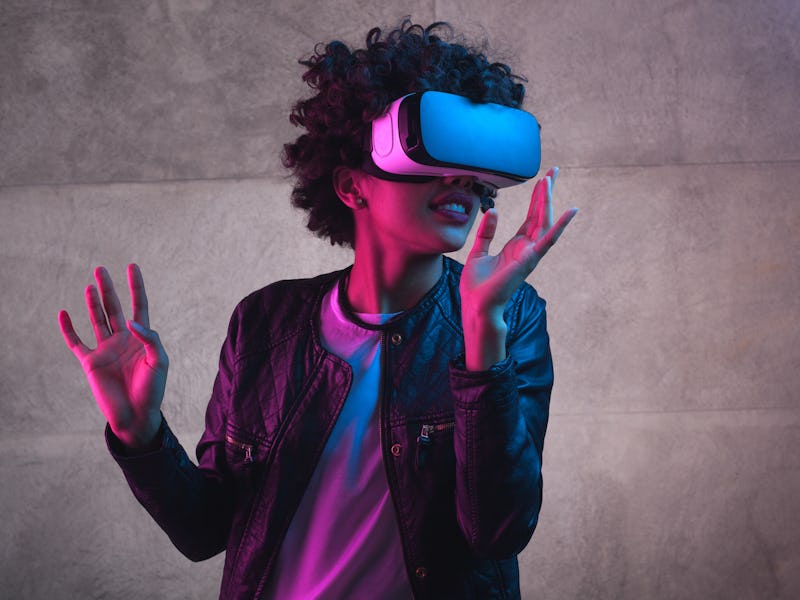Better storytelling could make some VR users less queasy
But only if you don't have much gaming experience to begin with.

Virtual reality (VR) goggles can take you to exotic lands, through unworldly gameplay and adventures -- but they can also make you puke. This experience has earned itself the name "cybersickness." Scientists still aren't totally sure why many experience cybersickness (though it may have something to do with your body interpreting the disorientation of VR as a poison in your system) but game designers and researchers continue to look for ways to get all of the benefits of VR without any of the nauseating downsides. With this goal in mind, a new study has demonstrated how for some users a better game-play narrative might improve their cybersickness symptoms.
The study was published in January in the journal International Journal of Human-Computer Studies and looked at how adding more narrative details to a user's experience would increase a sense of presence in the game and in turn lessen their cybersickness. The thinking behind this idea, write the authors, is that if a player is more focused and invested in the gameplay in front of them they'll be less focused on any physical discomfort they might be feeling. The research team from the University of Waterloo conducted this experient in two parts, first in a controlled laboratory study with 42 participants with varied gaming experience and second at THEMUSEUM in Kitchener, Ontario with 128 participants of varied ages and gaming experiences.
In both scenarios, the groups were divided evenly into groups with less gaming experience (where a high-level of gaming experience was considered five hours a day) and less gaming experience. All participants were introduced to the game-play mechanics of a space-based game called Lone Echo and then were asked to close their eyes and listen closely to a short narrative description of their mission. In each of the groups, some participants listened to a high-context scenario -- which was 49 seconds long -- while the other group listened to a context scenario with minimal details that was only 28 seconds.
For example, while the group in the minimal context scenario heard the game's virtual location described as "You will be located in a space station," the higher-context scenario participants instead heard "You will be located in a space station. The space station is part of an advanced mining facility located in the rings of Saturn. The space station mines Saturn's rings for valuable metals.”
After completing their seven-minute gaming experience the researchers had participants fill-out questionnaires to measure their sense of presence in the game as well as how sick it made them feel.
A participant plays Lone Echo during the VR trial portion of the experiment.
But, when looking through these responses, the researchers saw less connection between narrative and decreased cybersickness than they were expecting. While participants who heard the more detailed scenario did report feeling more present in the game, this sense of presence did not always correlate to less cybersickness as the researchers originally expected.
Outside the bounds of their original hypothesis, the team did notice a difference in reported cybersickness between gamers and non-gamers in the study. The researchers report that while non-gamers experience more cybersickness in the minimal detail scenario versus the higher detail scenario, gamers experienced about the same levels of cybersickness regardless.
Michael Barnett-Cowan, a Kinesiology professor and co-author of the study, said in a statement that this result still suggests how enriched narratives may be effective at minimizing cybersickness for these populations.
"People with little gaming experience are highly sensitive to conflicts between VR technology and the information they are taking in," said Barnett-Cowan. "Enriched narratives seem to enhance presence and reduce cybersickness due to the decreased focus on problems with the multiple inputs to their senses."
While these results may not be very conclusive, the authors write that this goes part-and-parcel with much of the literature about game design and cybersickness. However, they write that the results their study found in non-gamers present a promising avenue to further explore how game design and enhanced narratives may help reduce cybersickness in some users.
Abstract: Research has established a link between presence and cybersickness in virtual environments, but there is significant disagreement regarding the directionality of the relationship (positive or negative) between the two factors, and if the relationship is modulated by other top-down influences. Several studies have revealed a negative association between the factors, highlighting the prospect that manipulating one factor might affect the other. Here we examined if a top-down factor (narrative context) enhances presence, and whether this effect is associated with a decrease in cybersickness. We analyzed the association between responses to questionnaire measures of cybersickness and presence, as well as the degree to which their relationship was affected by the administration of an ‘enriched’ or ‘minimal’ verbal narrative context. The results of the first experiment, conducted in a controlled laboratory environment, revealed that enriched narrative was associated with increased presence, but that the reductive effect of narrative on cybersickness depended on video gaming experience. We also observed the expected negative association between presence and cybersickness, but only in the enriched narrative group. In a second experiment, conducted with a diverse sample at a public museum, we confirmed our previous finding that presence and cybersickness are negatively correlated, specifically when participants experienced an enriched narrative. We also confirmed the interaction between narrative and gaming experience with respect to cybersickness. These results highlight the complexity of the presence-cybersickness relationship, and confirm that both factors can be modulated in a beneficial manner for virtual reality users by means of top-down interventions.